| |
|
|
|
|
|
|
[1]
pipa (pre-Tang
Dynasty) |
|
[2]
Tang pipa (straight
neck) |
|
[3]
Tang pipa (bent
neck) |
|
[4]
modern pipa |
Fig.1:
Historical development of the pipa, a Chinese four stringed lute
-
- an illustration of the time
evolution from qin-pipa to the modern pipa through the influence
of hu-pipa (See the Note[1]
in the right panel for detailed explanation of the major fusion).
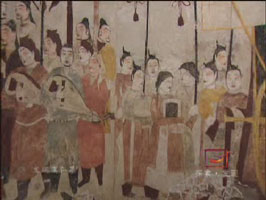
Playing the pipa horizontally with a
wooden plectrum was introduced during the Northern and Southern
Dynasty (420-589 AD)
|
During the
Northern and Southern Dynasty(420-589 AD), a similar pluck string instrument,
called oud
or barbat
with a crooked neck and four or five strings was introduced through the
Silk Road from Central Asia, known as the Hu Pipa ( Hu
stands for "foreign" in Chinese), which was played horizontally
with a wooden plectrum (see the picture below for the Tang
Dynasty pipa player). During the early Tang Dynasty, foreign
music became very popular. A fusion of the original Chinese pipa
and the "Hu pipa" took place such that the instrument
gradually became what the present pipa looks like toward the
middle of the Tang Dynasty (see pictures [1]-[4] in following
Note 1 in the right panel). Meanwhile the playing
method has been developed and repertoire increased.
One of the greatest developments was that the left hand became totally
free by holding the instrument vertically, Hu
stands for "foreign" in Chinese), which was played horizontally
with a wooden plectrum (see the picture below for the Tang
Dynasty pipa player). During the early Tang Dynasty, foreign
music became very popular. A fusion of the original Chinese pipa
and the "Hu pipa" took place such that the instrument
gradually became what the present pipa looks like toward the
middle of the Tang Dynasty (see pictures [1]-[4] in following
Note 1 in the right panel). Meanwhile the playing
method has been developed and repertoire increased.
One of the greatest developments was that the left hand became totally
free by holding the instrument vertically,
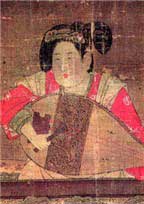
Pipa was played horizontally with
a wooden plectrum during the Tang Dynasty (618-907)
|
i.e. the
pipa rests on the thigh of the instrumentalist in an upright
position, and was played vertically with five fingers of the right hand
instead of horizontally with a plectrum (see the photo at the top of this
page). During
the Tang Dynasty (618 - 907), the pipa was one of the most popular
instruments, and it has maintained its appeal in solo as well as chamber
genres ever since. The
Tang pipa [3] was larger than the modern
instrument. It usually had four or five strings and fewer frets (compared
to the present day pipa). Probably influenced by the Hu pipa,
the Tang pipa was often played with a wooden plectrum, a technique
still used by its Japanese descendent, the biwa.
Since the mid Tang Dynasty, and particularly since the Song Dynasty
(960-1279), the instrument was gradually developed into the present
form of a lute played with fingernails, while the techniques with the
plectrum were totally abandoned. The strings of the instrument were
made of silk. Musicians used their real nails of the right hand to pluck
the strings. An exception to this is the Nanguan pipa which is popular
in Fujian Province (South-East China) and Taiwan in a particular kind
of traditional music called Nanguan which can be traced back to at least
the Song Dynasty. Pipa players in the Nanguan tradition play
the pipa horizontally and use a one piece plectrum just like the Tang
pipa.

The
above picture is from the Jin Dynasty (265-420 AD).
Note that
the second musician from the right side plays the pipa.
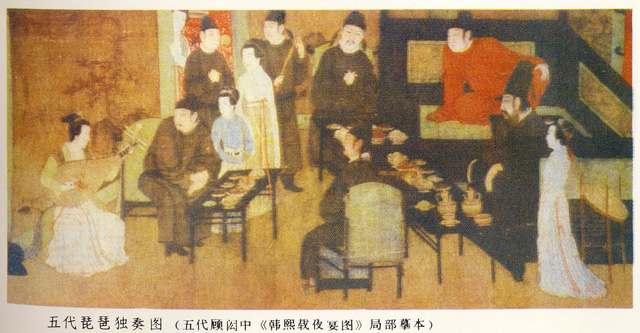
The
above is a painting from the "Five Dynasty" (907-960 AD)
depicting Tang pipa playing
Another
big change (fusion) occurred to the pipa during the first half of
the last century: the traditional pipa with silk strings and pentatonic
tuning has developed into the modern pipa with steel strings and
chromatic tuning (by increasing the number of frets). The modern
instrument is half-pear-shaped, with a short, bent neck, and has
30 frets which extend down the neck and onto the soundboard, giving
a wide range and a complete chromatic scale. The usual tuning is
A - E - D - A (La - Mi - Re - La). Since early last century, steel
strings began to be used by some musicians while most still kept
using silk strings. Since the 1950s, the making of the pipa has
become standardized in measure and the strings are made of steel
wrapped with nylon. Thus using the real nail becomes almost impossible.
Instead, a little plectrum (or fake nail) is attached to each finger
of the right hand. The plectrums are usually made of turtle shell
or special plastics.
Notation
for the pipa combines symbols for pitch (Kung-ch'e system) with
abbreviated characters for special finger techniques. Today, a simplified
version of music scores are commonly used in which numbers representing
pitches and symbols representing finger techniques are used. Meanwhile,
the standard Western music score has been used increasingly because
it has advantages in ensemble pieces and in particular for pipa
concertos
There
was a huge repertoire
of pipa music in Chinese history, particularly during
the Tang dynasty. But most of the pieces were lost. Fortunately,
there are precious pipa pieces handed down from one generation to
another by individual artists and scholars. Some pieces have been
preserved in Japan and other musical scores were discovered along
the Silk Road in Gansu Province, China, around 1900. These musical
notations, known as the Dunhuang scores from the Tang Dynasty (7-9th
century) triggered great concern and interest within China as well
as abroad. However, they remained a mystery until the early 1980s,
when the scholar, Prof. Ye Dong from the Shanghai Conservatory of
Music, successfully "decoded" 25 of the pieces. The beauty
and elegance of these pieces has thus first been revealed to the
public after having slept for a thousand years.
Pipa
music has been loved by Chinese people through the centuries. During
the Ming (1368-1644) and Qing (1645-1911) dynasties, various pipa
schools with different styles flourished in the South, centered
in Wuxi, Suzhou and Shanghai, and the North, centered in Beijing.
The development of finger techniques for both hands achieved a high
standard by the masters from each school. The present day pipa techniques
are mostly the fusion of those different schools. Now the pipa is
one of most popular instruments in China. Many of the compositions
that make up the traditional repertoire, which were handed down
from generation to generation through individual artists and scholars,
date back hundreds of years, while others are part of a body of
compositions that are dynamic and growing. In more recent times,
composers have explored the possibilities for the pipa and other
Chinese and Western instruments, even with orchestra. Nowadays,
there are a number of celebrated pipa concerti.
The
playing technique consists of the right hand fingers
plucking the strings and the left hand fingers touching the strings
in a variety of ways to create melodies, ornaments and special effects.
The fingers that pluck the strings move outwards, just the opposite
to guitar techniques. The frets are pretty high, which allows the
string to be pushed, twisted, and pressed. There are over 60 different
techniques that have been developed through the centuries.
|
|
| |
Liu Fang demonstrates
some basic pipa techniques. There are about 60 different
playing techniques for the pipa.
For
more music videos, click
here
|
|
The
pipa's technique is characterized by spectacular finger dexterity
and virtuosic programmatic effects. Rolls, slaps, pizzicato, harmonics,
and noises are often combined into extensive tone-poems vividly
describing famous battles or other exciting scenes, such as the
Ambush
(see the demo video #2 below). This type is called "wu qu"
(martial style). This example describes the decisive battle fought
in the second century BC between Chu (Xiang Yu) and Han (Liu Bang).
The instrument is also capable of more lyric effects, in the category
of "wen qu" (civil styles) such as the famous tunes "Fei
Hua Dian Cui" (Swirling snow decorates the evergreen,
see the demo video #1 below) or Sai
Shang qu (Songs from the other side of the
border). The former uses a scene in nature as metophor to describe
human feeling. The latter is said to represent the sorrowful song
of a Han dynasty (206 BC - 220 AD) noblewoman, who was compelled
for political reasons to marry a barbarian prince. This story appears
in several versions connected with the origin of the pipa. There
are also a lot of written texts and famous poems about the pipa
music played by virtuoso performers in history. For instance, the
following comments can be found in the texts from the Tang Dynasty
(618 - 907) describing the intensity of the Ambush played by artists
of that time : "... as if thousands of warriors and horses
are roaring on the battle field, as if the earth is torn and the
sky is falling". In his poem, the Pipa
Song, Bai Juyi, one of the leading poets in the Tang
Dynasty, described vividly the pipa music performed by an artist:
"... The thicker strings rattled like splatters of sudden rain,
the thinner ones hummed like a hushed whisper. Together they shaped
strands of melody, like larger and smaller pearls falling on a jade
plate."
|
[Note
1: the major fusion]
According to the historical records, before the introduction
of the Persian Barbat (which was called Hu-pipa by Chinese people),
the pipa Chinese musician performed with appeared to be like
the pipa in Fig.1[1] sometime
referred to as qin-pipa. Then some musicians went to China through
the Silk Road (around 5th century), bringing with them a kind
of lute-like instrument, the Persian Barbat (or the hu-pipa).
The latter didn't become popular until the early Tang Dynasty
(around the 7th century) when a group of brilliant musicians
were presented to the emperor. They were apparently amazing,
as the emperor fell in love with their music immediately. Soon
this foreign music became very popular in the Chinese capital
Chang'an (today's Xi'an) and the hu-pipa became a fashion. Some
Chinese musicians began to modify their instruments to conform
more to the shape of the Hu-pipa, producing something that was
called the Tang pipa (see Fig. 1 [2]
and [3]).
At first the neck was kept straight, and then it was bent, while
the sound body changed from being round to pear-shaped. The
reason for the change may be that people have the tendency to
follow fashion (which seems to be true even today). In the old
times, the emperors were the biggest fashion stars. What they
liked, everybody liked. Moreover, the Hu-pipa doesn't
"sing" the Chinese songs the way Chinese people were
used to, so the "voice" had to be changed. So were
the playing techniques (or rather, they maintained the original
finger nail techniques, instead of using a plectrum). Thus the
sound body became shallower compared to the "Hu-pipa"
in order to create a more crystal-like sound. And the development
continued ... Until the middle of last century, the pipa tuning
was still pentatonic, the strings were made of silk, and real
finger nails were used for plucking the strings. The modern
pipa has a complete chromatic scale (obtained by increasing
the number of frets); steel strings have replaced the silk ones,
and 5 finger plectra (faked nails) are used.
|
| [Note
2: some common confusions]
There are sometimes speculations in some recent pipa
literatures that the name pipa might have derived from
the Persian lute Barbat. This sounds more like a wild
speculation than a possibility, because (1)
the name pipa appeared in historical documents much
earlier than the arrival of the Barbat, (2)
the pronunciation of barbat can hardly be associated
with that of p'i-p'a, whereas for Chinese people, it is just
natural, as in the everyday language, the phonetic use of the
words such as "pi-pi-pa-pa" or "pi-li-pa-la"
is very common in describing similar sounds from nature or humanly-made
noise. (3) the Chinese characters were created
intelligently according to some basic principles: for instance,
the character(s) used as the name of an "object" should
reflect the "image" of the object or/and indicate
its meaning (in a self-explanatory way). Meanwhile, the pronunciation
is by no means randomly given. It must be related to the object
in one way or another.
In
the case of pipa, for example, the two characters were
written as or
or  in
the earliest documents, where
the in
the earliest documents, where
the  (wood) refers
to the material the pipa was made of, and the (wood) refers
to the material the pipa was made of, and the  is a symbol for "the hand/fingers",
implying "action" with fingers (thus finger techniques),
whereas the two symbols
is a symbol for "the hand/fingers",
implying "action" with fingers (thus finger techniques),
whereas the two symbols  and
and  on the left side of the characters are
"borrowed" simply because of their pronunciations.
In another words, they stand there in the formation of the two
characters for the pipa simply because their pronunciation
sounds similar to the two sounds produced by the two finger
techniques on the pipa. Later on (around the third century),
the written characters for pipa have
been standardized
as
on the left side of the characters are
"borrowed" simply because of their pronunciations.
In another words, they stand there in the formation of the two
characters for the pipa simply because their pronunciation
sounds similar to the two sounds produced by the two finger
techniques on the pipa. Later on (around the third century),
the written characters for pipa have
been standardized
as  where
the upper part of the characters where
the upper part of the characters is the common root for the names of the
ancient string instruments qin(
is the common root for the names of the
ancient string instruments qin( )
and se( )
and se( ). ).
There are also arguments based on the fact that most of Chinese
instruments have one-syllable names such as qin, se, sheng,
yu, zheng, ruan, xiao, xun, etc; whereas the instruments of
foreign origin have two syllable names such as erhu, yangqin,
suona etc. Needless
to say,
the origin of instruments are apparent even from the characters
used for their names, as they are either self-explanatary (
such as erhu and yangqin) or simply phonetic translation (Suona).
But
one cannot conclude that all instruments with two sylables are
foreign origin! This statement cannot be true, because written
Chinese and spoken Chinese were not the same**.
In written language, one character distinguishes from the other
quite obviously, even if they have the same pronunciation (In
Chinese, there are many characters which have the same pronunciation,
but mean different things). In spoken language, people try to
avoid using one-syllable words to name a thing, otherwise confusion
would be inevitable. What we see in the historical documents
are all written language. In the old times (say 2000 years ago)
people wrote on bamboo strips or on silk. When they could note
a thing with one character, they wouldn't care to use two (economy
was a virtue). However, if they found one character was not
enough, they would naturally use two or even more. Pipa
requires two characters, because it refers to two techniques
and two sounds. Moreover, even in written language, not all
instruments with two-syllable names were of foreign origin.
Examples are plenty, such as “bianzhong” , “paixiao”,
"xiantao", "qi-xian-qin", "qin-zheng",
etc. They are instruments from ancient China, even older than
pipa.
*Chinese
writing consists of an individual character or ideogram for
every syllable, each character representing a word or idea rather
than a sound; thus, problems caused by homonyms in spoken Chinese
are not a difficulty in written Chinese.
Whereas in every day spoken Chinese, people often avoid using
single character to call a thing. Additional characters (which
have somilar meaning or offer additional information) are often
used to avoid confusion, for instance, the zither qin
and zheng is often called guqin,
and guzheng
in spoken Chinese, where "gu" means ancient.
Since the "new culture" movement (starting from the
beginning of the last century), Chinese literatures have been
more and more linked to spoken language, and many words that
were used for every day spoken language have come into common
usage for written literature. The above-mentioned guqin
and guzheng are just few examples. |
|
 Hu
stands for "foreign" in Chinese), which was played horizontally
with a wooden plectrum (see the picture below for the Tang
Dynasty pipa player). During the early Tang Dynasty, foreign
music became very popular. A fusion of the original Chinese pipa
and the "Hu pipa" took place such that the instrument
gradually became what the present pipa looks like toward the
middle of the Tang Dynasty (see pictures [1]-[4] in following
Note 1 in the right panel). Meanwhile the playing
method has been developed and repertoire increased.
One of the greatest developments was that the left hand became totally
free by holding the instrument vertically,
Hu
stands for "foreign" in Chinese), which was played horizontally
with a wooden plectrum (see the picture below for the Tang
Dynasty pipa player). During the early Tang Dynasty, foreign
music became very popular. A fusion of the original Chinese pipa
and the "Hu pipa" took place such that the instrument
gradually became what the present pipa looks like toward the
middle of the Tang Dynasty (see pictures [1]-[4] in following
Note 1 in the right panel). Meanwhile the playing
method has been developed and repertoire increased.
One of the greatest developments was that the left hand became totally
free by holding the instrument vertically,
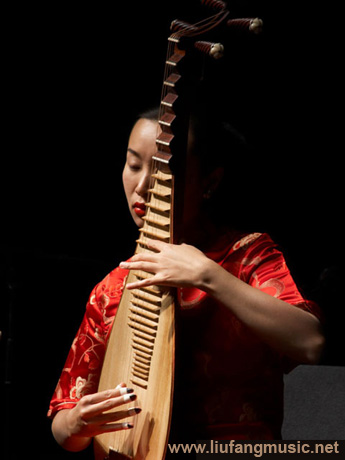
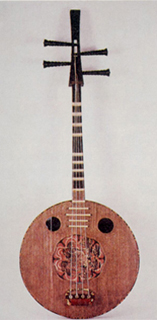



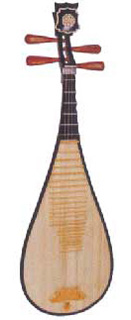




 is the common root for the names of the
ancient string instruments qin(
is the common root for the names of the
ancient string instruments qin(